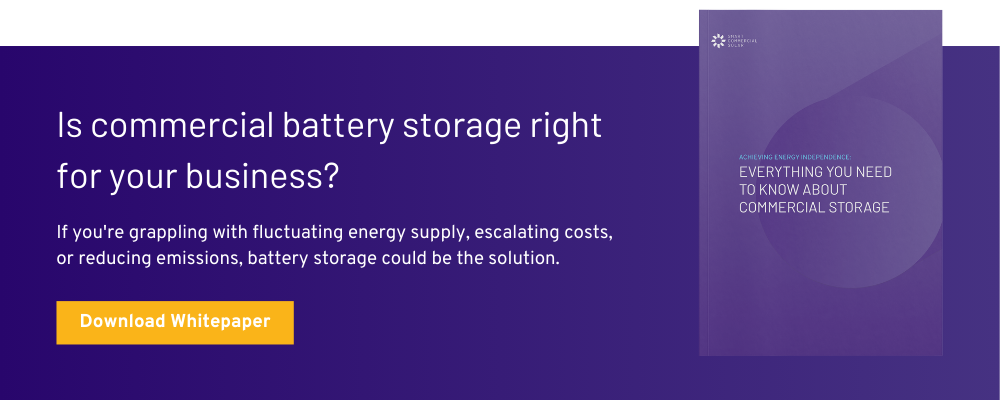Commercial solar installations have gained significant momentum as the business case for solar is a no brainer. However, generating renewables during the day is no longer enough to meet a company's ambitious renewable targets and many are not happy to accept increased solar export when looking to expand their existing system.
This is where commercial battery storage comes into play.
For organisations that need more on-site renewables (and that’s all of them) the right battery is critical in optimising the financial benefits and minimising the reliance on grid power. Understanding the functions and applications of battery storage is an important first step in evaluating whether your business is in a position to install a battery.
What Are The Benefits of Battery Storage?
Simply put, Battery Storage allows you to store energy and dispatch it when you need it. It involves the use of batteries that are charged by your solar system and discharged during night time loads or peak demand events. By integrating battery storage with commercial solar installations a businesses can convert more solar into usable electricity, generate increased savings by using cheap on-site renewables and reduce their reliance on the grid.
Embracing commercial battery storage opens the door to several key benefits, including:
- Increased Energy Independence: By integrating battery storage with commercial solar installations, businesses can store excess energy generated during the day and use it during off-peak periods, thereby reducing grid dependency and ensuring a more reliable power supply. A typical business offsetting 30% of their consumption with a solar system can get to 50-70% comfortably, and even 100% depending on your load profile.
- Cost Savings on Electricity Bills: By relying less on grid electricity, commercial battery storage allows businesses to reduce peak demand charges and shield themselves from volatile electricity prices, thereby can lower their electricity bills significantly. And as the cost of batteries continues to come down, the cost of electricity from the grid continues to climb. Based on recent energy rates, we are seeing payback periods for BESS systems 100kWh - 500kWh cool to an 8-year breakeven.
- Enhanced Energy Resilience: Battery storage systems can be configured to provide back up power during grid outages or emergencies. It is particularly important in industries that depend on uninterrupted power supply, such as healthcare, manufacturing, and telecommunications.
- Environmental Sustainability: By relying more on clean and renewable energy sources, businesses can reduce their carbon footprint and play an active role in mitigating climate change and promoting sustainable practices.
Applications of Commercial Battery Storage
The most basic application of commercial battery storage is to discharge through nighttime loads. However, that’s just one application of commercial battery storage.
Other applications of battery storage that people are perhaps less aware of include:
- Peak Shaving: Peak shaving involves reducing electricity consumption during peak demand events when utility rates are much higher. By discharging stored energy during these peak hours, businesses can lower a significant charge that makes up their energy bill.
- Load Shifting: Load shifting refers to the practice of redistributing energy consumption from high-demand periods to low-demand periods. Battery storage systems allow businesses to store excess energy during off-peak hours and use it during peak hours, effectively reducing electricity expenses and supporting grid stability.
- Microgrid: Commercial battery storage plays a crucial role in microgrid applications. Microgrids are localised energy systems that can operate independently from the main grid. By combining solar power with battery storage, businesses can create self-sustaining microgrids that provide reliable electricity, particularly in remote areas or end-of-grid locations.
- Grid Participation: The more sophisticated client may also want to dispatch their stored energy into the grid and participate in FCAS and NEM spot markets. By using your BESS in this way you can generate additional revenues outside of energy bill savings and improve your financial position.
Our C&I Storage Systems - A Case Study Feature
At Smart Commercial Solar, we have successfully implemented commercial and industrial (C&I) storage systems for numerous businesses across various industries. One particularly compelling example is a project we completed for the popular homewares retailer, Bunnings.
Smart Commercial Solar partnered with Bunnings to help them achieve their ambitious sustainability goals. With a target of being 30% renewable-powered by 2030, Bunnings has already surpassed expectations, with some stores generating up to 50% of their energy needs through rooftop solar. The collaboration between Smart and Bunnings resulted in the adoption of larger system sizes, including a notable 430kW system with a 600kWh battery at Bunnings Alice Springs. This cutting-edge installation successfully generates a remarkable 80% of the store's energy, demonstrating the substantial potential of large-scale battery systems for commercial establishments.
Read more about the value Bunnings derived from commercial solar batteries: Bunnings Warehouse
Should You Consider Battery Storage Now?
For those who have already installed solar and seen the benefits, battery storage is the next logical step. It may not stack up for everyone, and we'll be the first to tell you when it doesn't, however, we are starting to see battery uptake increase as energy rates continue to drive uncertainty in the long-term view of Australia's energy market. Battery storage insulates a business from price volatility in one of its largest cost inputs and provides energy independence - something that is becoming critical.
If you have seen a significant increase in your energy rates and already have solar, now is a good time to get a battery feasibility study to understand the latest numbers.
Our team can provide a comprehensive battery analysis that details the costs, savings and environmental benefits of installing a battery.
 You can also read the latest news and find out what’s happening in the commercial solar space at Smart Insights.
You can also read the latest news and find out what’s happening in the commercial solar space at Smart Insights.



